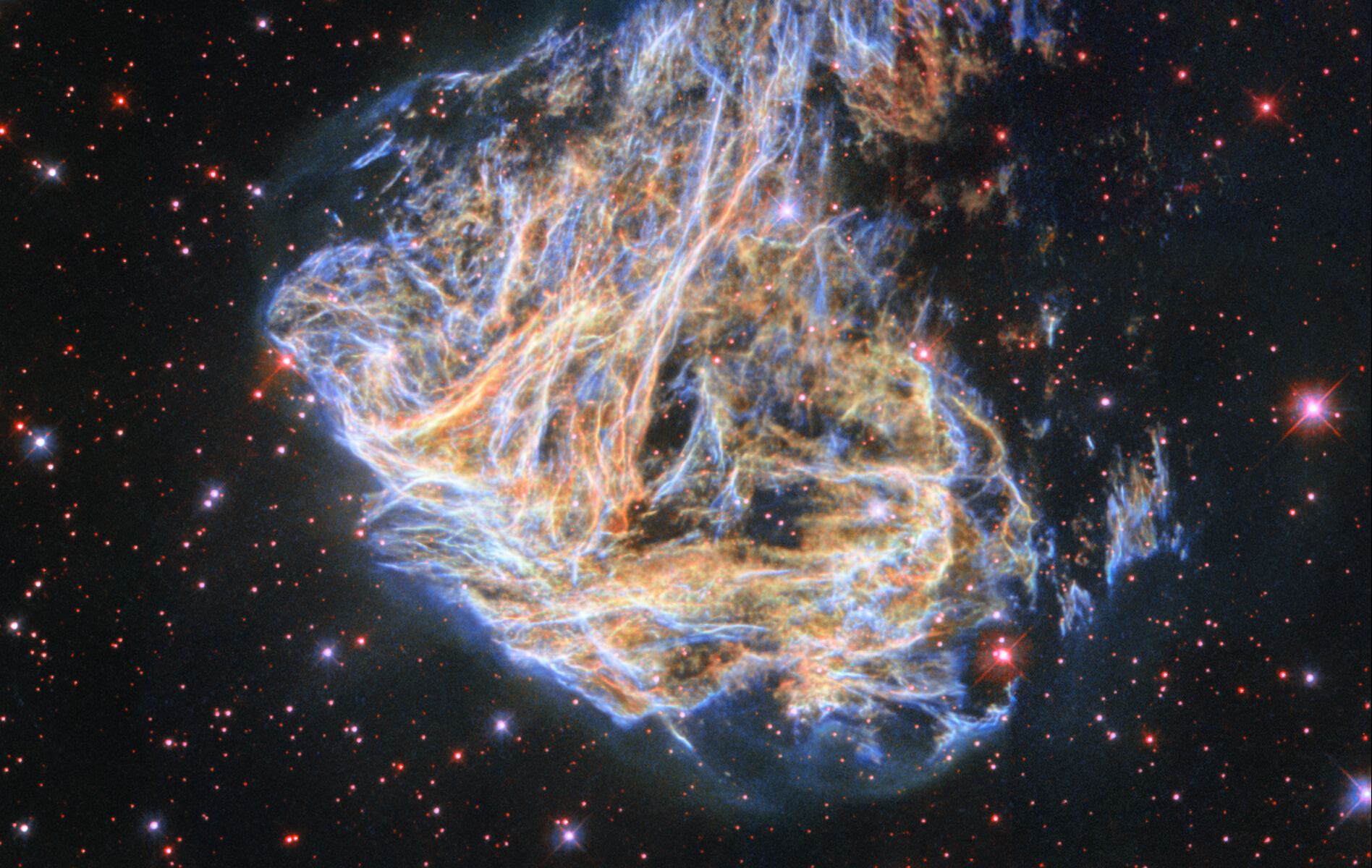The Hubble Space Telescope, to which we owe our current estimates for the age of the universe and the first detection of organic matter on an exoplanet, is very much doing science and still alive. It’s latest masterpiece remixes an old hit – apparently a growing trend in space science as well as space music.
Big Bada Boom
The story of this image begins roughly 165,000 years ago, when an unnamed O-type star in the Large Magellanic Cloud died in a type II supernova. Light from the explosion shot out in all directions, and about 160,000 years later a tiny cross section of that expanding sphere of light reached Earth. If humanity had modern telescopes around 3,000 BC, automated systems might have logged a blip in the southern constellation Dorado, well under the limits of human perception from such a great distance.
The supernova remnant took on a familiar form: a beautiful glowing cloud of expanding gas surrounding a pulsar – a super-dense and rapidly spinning neutron star with a powerful magnetic field. Shockwaves from the collapsing stellar core interacted with the nebula, coalescing the diffuse gas into filaments. Two especially hot and dense regions of gas shot away from the central pulsar in opposite directions, “bullets” likely fired off by the core’s powerful magnetic field. Within 5,000 years the nebula would be 75 light-years across, its heart still glowing at a million degrees.
People Are Noticing
The remnant was catalogued by Karl Henize in 1956 as part of a survey of emission nebulae in the Magellanic Clouds. Dubbed N49 (sometimes LMC N49) it was immediately recognized as a powerful radio emitter, and to this day it is the brightest supernova remnant in the Large Magellanic Cloud. On March 5, 1979 a historically powerful gamma ray burst was detected by all nine spacecraft of the interplanetary gamma-ray burst network. The source was quickly pinpointed as N49, which at this point was a usual suspect for this sort of mischief.
But The March 5 transient was so insanely powerful that a second otherwise-invisible neutron star in that region was hypothesized. The term “pulsar” wasn’t going to cut it for N49. This and other similar events spurred on the study of “soft gamma ray repeaters,” and eventually the creation of the “magnetar” classification in 1992.
The Hubble Space Telescoped first imaged N49 over 3 hours between November of 1998 and July of 2000. Three false-color images in the classic “Hubble Palette” – red for sulfur, blue for oxygen, and green for hydrogen – were captured using its Wide Field Planetary Camera 2 (WFPC2) and superimposed on a black-and-white base image, also captured by Hubble. The composited image was used in studies mainly focused on better understanding the nebula’s structure and environment.

Credit: NASA/ESA and The Hubble Heritage Team (STScI/AURA)
Acknowledgment: Y.-H. Chu (UIUC), S. Kulkarni (Caltech), and R. Rothschild (UCSD)
N49 has at least 26 other identifiers across different catalogues. The most common byname in the press is DEM L 190. The remnant has been imaged by notables like ROSAT, Chandra, and Spitzer, and was even mentioned in Chapter 9 of the companion book to Carl Sagan’s Cosmos.
The remnant’s intrigue comes not just from its brightness and powerful EM bursts, but also its asymmetry. Think of the stunning Ring Nebula, the Cat’s Eye, or the Lion Nebula. Each of these monuments to the awesome beauty of the cosmos was created by the same basic process as N49. An observer of most planetary nebulae could be forgiven for entertaining the thought of a cosmic watchmaker.
By comparison N49 looks like that watchmaker tried to flip an omelet and really messed up. Pinning down why and how the occasional stellar remnant gets so messy will help us understand stellar life cycles more completely.

Credit:
X-ray: NASA/CXC/Caltech/S.Kulkarni et al.
Optical: NASA/STScI/UIUC/Y.H.Chu & R.Williams et al.
IR: NASA/JPL-Caltech/R.Gehrz et al.

Credit:
X-ray: NASA/CXC/Penn State/S.Park et al.
Optical: NASA/STScI/UIUC/Y.H.Chu & R.Williams et al.
Synthesis
As imaging technology improves, from time to time the ESA/Hubble team revisits targets. For example, back in 2003 data from two UV filters centered at 300nm & 380nm were captured at the same time as the others but were not included in the original composite. For the 2022 image they were added in, and luminosity was depicted using red light instead of white, in part to give background stars a more natural-looking color.
The past nineteen years have also seen great strides in noise reduction and data stretching algorithms, which when applied to the updated image reveal an unprecedented level of detail. Fun fact, technically none of this improves the image’s resolution, which is limited by WFPC2’s performance back in the day. But that’s just a technicality – there’s no arguing the new 2022 image shows significantly more detail.
What will this new photo reveal to discerning eyes? That’s the fun part. Maybe the more detailed filaments will help astronomers better model especially violent stellar deaths. In a few years this photo may help answer questions we don’t even have yet.
For More Information:
- ESA’s page on Revisiting a celestial fireworks display
- NASA | ESA Hubble’s page on Revisiting a Celestial Fireworks Display (Colours & filters on the bottom-right of the page)
- Up your work chat game with NASA | ESA Hubble on Giphy

